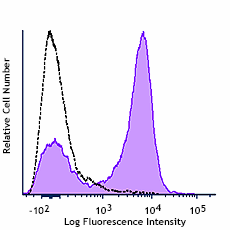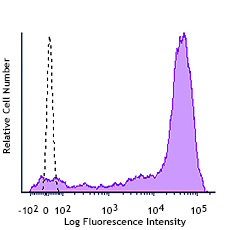- Regulatory Status
- RUO
- Ave. Rating
- Submit a Review
- Product Citations
- publications

-

Human peripheral blood lymphocytes were stained with APC/Cyanine7 streptavidin alone (open histogram) or Biotin anti-human CD3 (clone UCHT1) followed by (APC/Cyanine7) Streptavidin (filled histogram).
| Cat # | Size | Price | Quantity Check Availability | Save | ||
|---|---|---|---|---|---|---|
| 405208 | 100 µg | $206 | ||||
Streptavidin binds to biotin with high affinity. Streptavidin-APC/Cyanine7 is useful for detecting biotinylated antibodies. The excitation of APC/Cyanine7 by 600-635 nm laser light induces a fluorescence emission maximum of 780 nm.
Product DetailsProduct Details
- Verified Reactivity
- Human, Mouse, Rat, All Species
- Formulation
- Phosphate-buffered solution, pH 7.2, containing 0.09% sodium azide.
- Preparation
- Streptavidin is conjugated with APC/Cyanine7 under optimal conditions.
- Concentration
- 0.2 mg/ml (concentration relates to the Streptavidin only component of the conjugate)
- Storage & Handling
- The Streptavidin APC/Cyanine7 solution should be stored undiluted between 2°C and 8°C, and protected from prolonged exposure to light. Do not freeze.
- Application
-
FC - Quality tested
ICFC - Verified
- Recommended Usage
-
Each lot of this Streptavidin APC/Cyanine7 is quality control tested by immunofluorescent staining with flow cytometric analysis. The concentration provided is based upon molecular mass of streptavidin independent of any additional molecular mass that might be added by the APC/Cyanine7 conjugation. For immunofluorescent staining, the recommended use of this reagent is =0.06 µg per 106 cells in 100 µl staining volume. It is recommended that the reagent be titrated for optimal performance for each application.
- Excitation Laser
-
Red Laser (633 nm)
- Application Notes
-
Streptavidin-Allophycocyanin/Cyanine7 (APC/Cyanine7) is useful as a second step reagent for indirect immunofluorescent staining, when used in conjunction with biotinylated primary antibodies. The average molecular weight of Streptavidin-APC/Cyanine7 is 350 kD and Streptavidin alone is 52 kD.
- Additional Product Notes
-
BioLegend is in the process of converting the name APC/Cy7 to APC/Cyanine7. The dye molecule remains the same, so you should expect the same quality and performance from our APC/Cyanine7 products. Please contact Technical Service if you have any questions.
-
Application References
(PubMed link indicates BioLegend citation) -
- Maresz K, et al. 2005. J. Neurochemistry 95:437.
- Ponomarev ED, et al. 2006. J. Immunol. 176:1402.PubMed.
- Ponomarev ED, et al. 2007. J. Immunol. 178:39.
- Mann MK, et al. 2007. J. Immunol. 178:3447.PubMed
- Ponomarev ED,et al.2005.J. Immunol Methods.300:32. PubMed
- Cao YA, et al. 2008. Blood PubMed
- Garidou L, et al. 2009. J. Virol. PubMed
- Dolgachev V, et al. 2009. J. Immunol. 183:5705. PubMed
- Sountoulidis A, et al. 2012. PLoS One. 7:e41460. PubMed.
- Izumi T, et al. 2013. Cytotherapy. 15:481. PubMed
- Hamanaka S, et al. 2013. Biochem Biophys Res Commun. 435:586. PubMed
- Prince J, et al. 2013. J. Immunol. 191:4709. PubMed
- Phanse Y, et al. 2013. Acta Biomater. 9:8902. PubMed
- Orre M, et al. 2014. Neurbiol Aging. 35:1. PubMed
- Barbera M, et al. 2014. Gut. 64:11. PubMed
- Zhang Y, et al. 2014. Infect Immun. 82:1698. PubMed
- Peterson BC, et al. 2014. J Leukoc Biol. 95:809. PubMed
- Barbera M, et al. 2015. Gut. 64:11. PubMed
- Charmsaz S, et al. 2015. PLoS One. 10:130692. PubMed
- Product Citations
-
Antigen Details
- Gene ID
- NA
- UniProt
- View information about Biotin on UniProt.org
 Login/Register
Login/Register 

















Follow Us